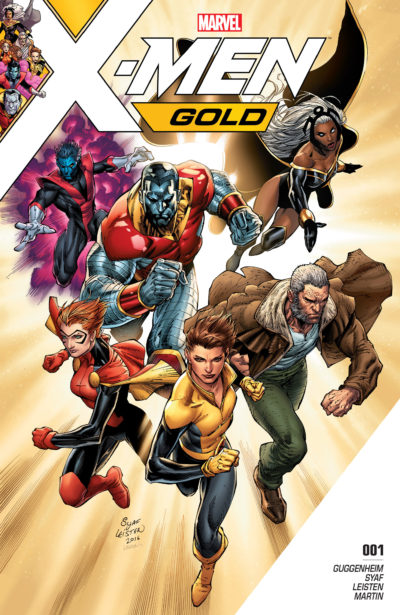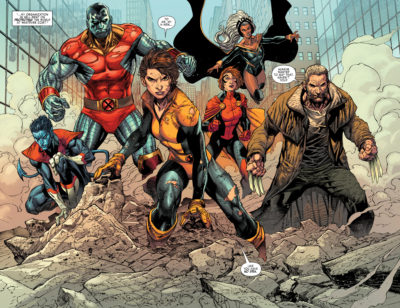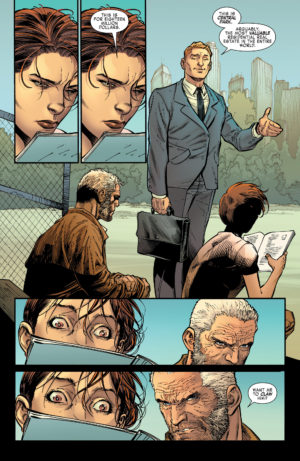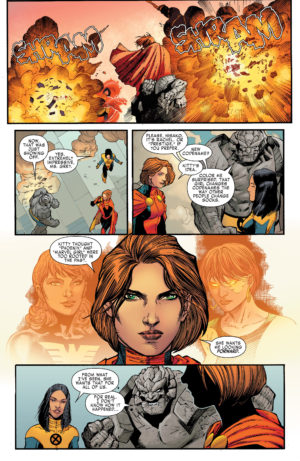There is a recurring theme in today’s X-Men Gold #1: “past is prologue.”
It’s a theme I lean into heavily in my every day life. Being obsessed with data and truth tends to emphasize the impact of the past on the present. Most fresh starts in life consist of actors with past track records of behavior, models of behavior that have previously been described. They aren’t really that fresh
That’s part of why everyone loves a sudden success story, whether that’s an indie movie or a hot new start-up. It’s not just the success we’re celebrating, but the subversion of trends and predictability.
When you swim in the data of a thing all the time, it’s really hard to be pleasantly surprised by those fresh starts. I looked at the return order probability of hundreds of start-ups. There was no novel return curve to discover. After the first few dozen, everyone snapped into a story I had seen before.
Comics can feel like that, too. It’s a tiny industry where the most read book never even approaches a million eyeballs (and I’m counting individual eyeballs here, not pairs).
Marvel and DC are creating most of their stories with characters who have been around for over 25 years. Most of them have been combined into the same teams before. Most of the writers and artists are part of a crowd that flip flops back and forth, with stops at Image or another indie to take a breather. Most of the world-changing stories just echo back and forth between the big two publishers, copies of copies of copies of big ideas that have already been had.
 Past is prologue. We’ve seen it before, so we know what we’ll see. And, like in the rest of life, we’re pleasantly surprised when we get something truly novel…
Past is prologue. We’ve seen it before, so we know what we’ll see. And, like in the rest of life, we’re pleasantly surprised when we get something truly novel…
…and then we want more and more of that novel thing, until it’s our new past and becomes our next prologue.
When Marvel or DC say they are launching something “new,” it’s with the caveat that a seasoned reader already knows the introduction to this story.
The question is: does that mean you can predict where it will wind up?
![]()
X-Men Gold #1 (digital)
![]() Written by Marc Guggenheim with pencils by Ardian Syaf, inks by Jay Leisten, colors by Frank Martin, and letters by VC’s Cory Petit.
Written by Marc Guggenheim with pencils by Ardian Syaf, inks by Jay Leisten, colors by Frank Martin, and letters by VC’s Cory Petit.
CK Says: Buy it! Bottom Line: Guggenheim’s new take on flagship X-Men feels familiar and maybe a bit fan-service-y, but that doesn’t stop it from being remarkably fresh as it achieves its back-to-basics aim: the X-Men feel like heroes again.
![]()
Marc Guggenheim takes his second swing at the X-Men in three years, and this one is a solid hit. X-Men Gold is a delightful first issue with hints of many past teams, but it has a fresh outlook that’s intent on minimizing the recent past as leaden prologue weighing the series down from the start.
The X-Men’s past being prologue isn’t something you’ll often hear me lament,  as a studied X-fan of over 25 years. I’m all for continuity-dense mining of years of history, but Guggenheim -the successful creator of CW’s Arrow – was wise enough to know now isn’t the time.
as a studied X-fan of over 25 years. I’m all for continuity-dense mining of years of history, but Guggenheim -the successful creator of CW’s Arrow – was wise enough to know now isn’t the time.
What’s X-Men Gold all about? The story’s title says it all: “Back to Basics.”
The X-Men are back to being a team who scrambles the Blackwing because they hear someone is in trouble – mutant or not. Or, at least, that’s what newly-minted leader Kitty Pryde wants them to be, which is how we wind up in medias res with the team facing down Terrax, whose previous X-book exposure comes solely from Dazzler.
Why are they fighting him? Because The Avengers and The Champions didn’t show up and the X-Men are heroes.
The choice to start with the team mid-fight is incredibly smart. It not only gets the reader right into action, but it spares Guggenheim from playing the rehashing game.
I don’t just mean rehashing who the characters are and their recent history, but rehashing past initial X-Men outings. He wants us to read the X-Men as heroes, so he gives us them as heroes without any explanation required. To recall one of those past outings, it’s as if Joss Whedon’s Astonishing X-Men started halfway through the second issue. Sure, we lose the jokes about who has slept with who and having “cloud hair,” but that’s what we wanted from Whedon.
It also allows Adrian Syaf to stretch out and show his subtle new spins on the team’s costumes (and one major refresh) in action. Kitty is in the blue-and-gold standard look, while Storm and Colossus are back to old signatures with simplified lines and more prominent X theming. 
Syaf treads a fine line between bold, life-like depictions and big, cartoonish moments. He does massive scale well, playing the team against several large buildings to be saved or potentially destroyed. He also draws a satisfyingly large Colossus.
His faces are his strongest point, but for that reason I found a few of his choices a bit jarring. His Kitty is a bit too masculine for my preference, drawing her as a short-haired Kristen Stewart. And, his Storm doesn’t feel settled yet, with generic features that wouldn’t read as Ororo without her coloring.
Speaking of coloring, I like Frank Martin’s glossy look, with a bold color palette and plenty of highlights. Comics can trend very muddy with lots of orange and green mid-tones. We get that in the dusty city scenes here, and on Logan, but there’s a delightful amount of unrestrained primary and secondary colors throughout the book. It feels like the red and gold of Rachel Summers’ new costume is a touchtone for the palette as a whole.
Guggenheim’s selected team is heavy with significance no matter what angle you view it from.
- Storm + Logan + Nightcrawler + Colossus = early Claremont X-Men
- Nightcrawler + Kitty Pryde + Rachel Summers = Excalibur
- Logan + Kitty = master and student
- Kitty + Colossus = young girl and her handsome crush
This issue neatly subverts most of those dynamics on panel, and where it doesn’t recent history does the trick. Kitty Pryde is leading the team, because she’s might be the only experienced mutant with any optimism left. Storm is the consummate expert, but her faith is shaken after the team’s war with the Inhumans (telegraphed more in X-Men Prime). Colossus is fresh from several years of battling demons and seeking the family, and Kitty doesn’t want a retread of their relationship.
The other half of the team are more the mystery.
Rachel Summers is always difficult to write as anything other than headstrong young Jean Grey, and we’ve already got one of those right now. Breaking her away from the team in War of Kings was a gift, as was the previous era casting her as the impetuous psychic, bristling at still being a junior member of a team she’s spent her entire adult life serving alongside.
Kitty makes that subtext text, imposing a rule on her best friend Rachel – she’s on the team, but she can’t do it under some previous code name or outfit that’s an echo of her mother. Instead, we get “Prestige” – an all new Rachel.
We don’t get much else here beyond the costume. Will the new look come with the same act-first, question later attitude she’s shown recently?
Nightcrawler doesn’t get much to do here, and it feels like Magik or another teleporter could have easily been swapped in. However, we do see him briefly as Storm’s confessor, indicating he might have a role to play as Kitty’s conscience as she makes difficult new decisions.
As for the Old Man version of Logan… eh. He’s the flavor of the moment thanks to the successful Hugh Jackman film, but it’s clear Guggenheim has him here to try to subvert a lot of old master/student moments with Kitty, now the leader. Given the depth of her relationship with all the other members here, I could have done without him – but, I’ll give it the benefit of the doubt.
Add in a few X-students in training, the budget problems that seem to always plague Kitty, and a time-honored old X-Men baseball game, and you’ve got a rock solid comic in your hands.
Only a pair elements create a slight drag on this book’s narrative momentum. Opening with a TV commentator justifying speciesism as making more sense than racism feels too on-the-nose, and we’ve seen a lot of X-Men comics start that way. Kitty’s big hero speech should be about owning up to the X-Men’s recent terrorism to a group of bystanders, but it feels like an ham-fisted apology instead (both for racism and for recent X-Men stories).
The issue’s end shows us we might not be back to something as basic as we thought, since the team does wind up facing off against an enemy gang of mutants. But, unlike our primary cast, no one could ever say they were the mutants you were expecting to see.
X-Men Gold was a deeply satisfying read. Whether you’re brand new to X-Men or burnt out on the past few years of rough times for our heroes, this new debut feels right without being a rerun of anything prior. Can Guggenheim maintain this feel on a bi-weekly schedule while churning out stories have heft?
Tune back in two weeks to find out.
[…] the other X-Men relaunch books? Check out my reviews of X-Men Prime and X-Men Gold #1, plus learn how to read and collect every issue of every X-Men title, […]